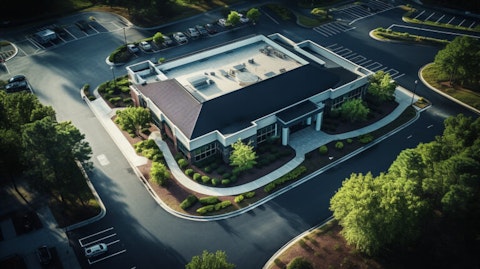AvalonBay Communities, Inc. (NYSE:AVB) Q3 2023 Earnings Call Transcript October 26, 2023
Operator: Welcome, ladies and gentlemen, and welcome to AvalonBay Communities Third Quarter 2023 Earnings Conference Call. At this time all participants are in a listen-only mode. Following remarks by the company, we will conduct a question-and-answer session. [Operator Instructions] Your host for today’s conference call is Mr. Jason Reilley, Vice President of Investor Relations. Mr. Reilley, you may begin your conference.
Jason Reilley: Thank you, Rob, and welcome to AvalonBay Communities third quarter 2023 earnings conference call. Before we begin, please note that forward-looking statements may be made during this discussion. There are a variety of risks and uncertainties associated with forward-looking statements, and actual results may differ materially. There is a discussion of these risks and uncertainties in yesterday afternoon’s press release as well as in the company’s Form 10-K and Form 10-Q filed with the SEC. As usual, this press release does include an attachment with definitions and reconciliations of non-GAAP financial measures and other terms, which may be used in today’s discussion. The attachment is also available on our website at www.avalonbay.com/earnings, and we encourage you to refer to this information during the review of our operating results and financial performance.

An aerial view of a large real estate brokerage office.
And with that, I will turn the call over to Ben Schall, CEO and President of AvalonBay Communities, for his remarks. Ben?
Ben Schall: Thank you, Jason, and thank you, everyone, for joining us. In keeping with our custom, we posted a presentation last night to accompany our earnings release. In addition to my opening comments, you will hear from Sean on our operating performance and revenue building blocks for 2024; from Matt on the significant earnings being generated by our development projects and lease-up; and from Kevin on the strength of our balance sheet. I want to start with my thanks to the AvalonBay team and our 3000-plus associates for delivering another strong quarter of financial performance and operating results. Particularly in the current environment of higher interest rates and uncertain cap rates, we are laser-focused on driving cash flow growth from our portfolio.
The bottom line results from our operating model transformation led by our on-site and centralized teams and powered by our technology, revenue management and data science teams and proprietary systems continue to outpace expectations. Our strong operating performance also speaks to our portfolio positioning, which is 70% suburban and primarily in suburban coastal markets, which continue to benefit from a combination of steady demand and limited new supply. Turning to Slide 4 in the presentation. We grew core FFO by 6.4% in Q3, which was $0.06 ahead of our expectations. This outperformance was primarily driven by better-than-expected revenue growth, which positions us well, as we enter the traditional slower leasing season. As shown on the bottom of Slide 4, we have raised $855 million of capital this year at a 4.3% initial cost, which includes the drawdown of our $500 million equity forward, which we priced at $250 per share and with the remainder coming from asset sales that we’ve sold at an average cap rate of 4.7%.
We completed three development projects in Q3, two in suburban submarkets in the Northeast and one in Miami at a 7.2% stabilized yield. As Matt will emphasize later, our lease-up communities continue to outperform our original expectations by a wide margin. These projects are funded with yesterday’s capital, at yesterday’s capital cost and are slated to generate outsized value creation and earnings for investors. We also started two projects this quarter, one in Princeton, New Jersey and one in South Miami, with projected yields in the mid-6% range. I will come back to our positioning on new development and capital allocation at the end of our prepared remarks. In Q3, we made $50 million of commitments under our structured investment program or SIP and feel fortunate to be building this book of business in today’s environment with these new commitments generating an attractive 13% return.
Slide five provides the breakdown of our Q3 revenue outperformance relative to guidance from the end of July with a 30 basis point uplift from higher-than-expected occupancy, 20 basis points from higher rates and 10 basis points from improving bad debt. Turning to slide six. We’ve exceeded and raised guidance three times this year. We now expect core FFO to grow 8.6% in 2023, which is 330 basis points above our initial expectations for the year. Same-store revenue growth expectations are up 130 basis points. Expenses are down slightly, leading to NOI growth of 6.3%. And with that, I’ll turn it to Sean to comment on the favorable demand and supply drivers in our markets and provide a fuller operating update.
Sean Breslin: Thanks, Ben. As we start to look forward to 2024, I thought I’d provide some initial thoughts on two topics. First, I’d like to highlight a few macro factors that will support the performance of our portfolio in the coming year. And then second, share a few building blocks as it relates to the outlook for 2024 revenue growth specifically. Starting on slide seven, we believe our portfolio is well positioned as it relates to rental affordability, particularly as compared to other regions of the country and single-family for sale product. In Chart 1, you can see that rental affordability in our established regions is actually better than pre-pandemic levels, given the strong wage growth that’s been experienced over the last few years.
And in Chart 2, difference between the cost of owning the median-price home and median rent in our established regions has increased by roughly 10x if you look at the first three quarters of 2023 relative to the average during 2020, which certainly makes apartment living in a more attractive option in these regions. We’ve already seen the impact of this trend in multiple data points. For example, the volume of existing home sales in our established regions has declined by roughly 25% over the past year. And in our own portfolio, the percentage of move-outs to purchase a home has dipped below 10% this year well below the mid-teens long-term average. Moving to slide eight. Our portfolio is also relatively insulated from new supply particularly as compared to the Sunbelt.
In our established regions, we expect new multifamily deliveries of approximately 1.5% of existing stock. And in the specific submarkets where we own assets, new supply is projected to be roughly 1% of stock. This bodes well for revenue growth in all market cycles, but is a particularly valuable attribute of our portfolio, if we experience a weaker economic environment during 2024. Transitioning to slide nine, I’d like to highlight four specific building blocks for 2024 revenue growth. First, the embedded growth in the rent roll from leases we’ve executed during 2023 stands at approximately 1.5%, which is above our long-term average at this point of the year. Second, our current loss to lease is roughly 2%, led by the East Coast at about 2.5%, while the West Coast and expansion regions trailed behind at approximately 1.5% and 70 basis points respectively.
Third, we continue to drive incremental revenue from our operating model initiatives. For example, the September revenue from our Avalon Connect offering was about 40% greater than the average monthly revenue for the first nine months of the year and that monthly revenue run rate will continue to grow during the last two months of 2023 and throughout 2024. Lastly we’re expecting a continued tailwind from the normalization of bad debt. During the first half of the year, underlying bad debt averaged approximately 2.7% as compared to the Q3 average of roughly 2% and we expect continued improvement as we move through 2024. The benefit from an improvement in underlying bad debt will be partially offset by the loss of rent relief we’ve recognized in 2023, but still be a net meaningful benefit for 2024.
Taken together these building blocks should support healthy revenue growth during the upcoming year. So with that, I’ll turn it over to Matt to address our lease-up activity and structured investment platform. Matt?
Matt Birenbaum: All right. Thanks Sean. Turning to slide 10. Our lease-ups continue to deliver outstanding results, laying the foundation for strong future growth in both earnings and NAV. We have five development communities that had active leasing in Q3 and those five deals are leasing up at rents that are $485 per month or 17% above our initial underwriting. This in turn is driving a 90 basis point increase in the yield on these investments to 7.4% far above any estimate of current cap rates and even further above the cost of capital we sourced to fund these deals back when they broke ground several years ago. After a relatively light year of deliveries in 2023, we do expect to see a significant increase in our apartment completions in 2024, which will provide incremental NOI and FFO as these communities reach stabilization.
Slide 11 provides an update on our structured investment program where we initiated two new investments last quarter and $52 million at an all-in average interest rate of 13%. As we’ve discussed on prior calls these are three to five-year investments where we provide capital to merchant builders that sits above the construction loan but below common equity in the capital structure. We’re still early in the build up of this new line of business and expect it to continue to grow to roughly $400 million over the next few years, providing a nice tailwind to earnings growth as these dollars get invested and start earning a return. We’re also fortunate that we’re able to underwrite most of this business in today’s more restrictive environment providing a strong risk-adjusted return particularly for the latest additions to the program.
And with that I’ll turn it over to Kevin.
Kevin O’Shea: Thanks Matt. Turning to the next few slides. We continue to enjoy tremendous financial strength and flexibility both from a balance sheet and a liquidity perspective. Specifically from a balance sheet perspective as you can see on slide 12, we enjoy low leverage with net debt to EBITDA of 4.1 times, which is below our target range of five times to six times. Our interest coverage ratio and our unencumbered NOI percentage are at near record levels of 7.5 times and 95% respectively. Our debt maturities are well laddered with a weighted average years to maturity of 7.5 years. And our development underway is nearly 100% match-funded essentially with yesterday’s lower cost of capital, which in turn helps ensure that these projects provide earnings and NAV growth when they are completed and stabilized.
In addition from a liquidity perspective as shown on slide 13, we continue to maintain a high level of excess liquidity relative to our open commitments for development and structured investment products as of quarter end. Specifically we enjoy $1.5 billion of excess liquidity. And so as a result, we continue to enjoy tremendous financial strength and stability and the flexibility to pursue attractive growth opportunities that may emerge across our investment platforms in the coming months. And with that, I’ll turn it back to Ben.
Ben Schall: All right. Thanks, Kevin. We have consistently maintained a strong balance sheet throughout cycles. And as a result, we are well prepared for the current environment. As we have shown over the past couple of years, we proactively adjusted our capital sourcing and capital allocation activities based on changes in the environment as emphasized on slide 14. We locked in our equity forward in early 2022 to pre-fund future development activity. We shifted in the second half of 2022 and in 2023 to be a net seller of assets with a portion of the proceeds being utilized to fund acquisitions as we reshape the portfolio and the balance to fund accretive development. And we have continued to be responsive in adjusting our development start activity, reducing starts last year and this year as our cost of capital changed.
As we’ve emphasized, we are 95% match funded on our development underway, which means all of that capital has already been raised at an attractive initial cost and allows us to deliver projects in 2024 and 2025 that will generate significant earnings and value. On a go-forward basis, we have raised our return requirements on new development. For a standard development deal, our target return was in the low to mid-6s in the middle of the year and is in the mid- to high 6s today. These target returns are up over 100 basis points since last year with the goal of underwriting 100 to 150 basis points of spread between development yields and market cap rates. We expect to be in the lower development — we expect to be in a lower development start environment in the coming quarters and with spreads at the tighter end of this range after a number of years of outsized development profit margins.
And while in the current environment we’re focused on maintaining our balance sheet strength, we do believe that we are well positioned given our low leverage, ample liquidity and unique strategic capabilities to capitalize on opportunities that might result from market dislocations. In the near term, while volumes are modest, we’re able to deploy capital at double-digit returns through our SIP program. Slide 15 concludes our prepared remarks with our key takeaways. We continue to deliver strong operating results with tailwinds specific to our suburban coastal markets incremental NOI to come from our developments and lease-up and all supported by a fantastic balance sheet. And with that, operator, please open the line for questions.
See also 12 Best Undervalued Energy Stocks To Buy According to Analysts and 20 States with the Highest Alcohol and Beer Tax.
Q&A Session
Follow Avalonbay Communities Inc (NYSE:AVB)
Follow Avalonbay Communities Inc (NYSE:AVB)
Operator: Thank you. At this time, we will be conducting a question-and-answer session. [Operator Instructions] Our first question comes from Eric Wolfe with Citi. Please proceed with your question.
Eric Wolfe: Hi. Thanks for taking my questions. I think you said that you raised your development yields, that’s underwritten to be mid to high 6s. Just curious why you think that’s the appropriate level? And what percentage of your future development pipeline with that criteria? So if you just take your rights pipeline and everything else what percentage would be started under that criteria?
Matt Birenbaum: Hi, Eric. It’s Matt. I guess I can speak to that one a little bit. As Ben mentioned, we’re really trying to preserve that spread of 100 to 150 basis points between cap rates and development yields. And so mid to high six is a reflection of where we think. It’s very hard to know where spot cap rates would be today. I think that we had a pretty good sense of where they were over the summer when transaction activity has started to pick up with the most current rise in rates. It’s a little bit of a guess but if you think cap rates are maybe in the mid-5s then that would translate into development yields in the mid to high 6s to preserve that spread. It does vary by product type and by region of course. But — so that’s really kind of the thinking behind that.
And as it relates to what percentage of the current book meets that threshold it’s actually hard to say because things are moving around so much. And what we found is that until we have CDs permits in hand hard drawings to bid on the street we don’t really know where hard costs are today. They are starting to come down but you don’t necessarily realize that on an estimate that you really want to realize that when you’re ready to go. So, what I would say is we have plenty of deals that do clear that hurdle. And indeed we just started two deals this quarter. We’re in the mid-6s. And we have at least a couple more that could start over the next couple of quarters that we think are kind of in that position. We do have some that on the most current underwriting from six to 12 months ago will probably fall a little bit short of that.
And in many of those cases, we’re hoping that with some value engineering maybe some changes to the land economics with the landowner and changes in hard costs that by the time those deals are ready to go they will meet that.
Eric Wolfe: Understood. That’s helpful. And then you gave some good detail on the building blocks for same-store revenue growth for next year. Obviously the one piece that’s missing is just your expectation around what market rents will do. Then I know it’s too early to provide that but I was just hoping you could give us a sense for the process that you go through in terms of figuring that out whether you’re building up or down? And then sort of if you were to do it today if you just have a sense for what market rate growth would look like?
Sean Breslin: Yes, Eric it’s Sean. Good question. Good crystal ball question I guess I’ll characterize it as. But we sort of do two things. We have a macro view and then there’s sort of a grassroots bottom-up approach. From a macro perspective in terms of providing commentary today, that’s probably where it’s been a time which is — based on what we know today we would anticipate that from a demand standpoint things would decelerate as we move into 2024 just given what we’ve been seeing in terms of the expectation for slower job and wage growth and other potential headwinds as it relates to whether it’s oil prices, obviously, interest costs, student loans, et cetera et cetera. There’s a number of macro factors that appear to be more headwinds.
We take a really good look at the native consensus forecast for a number of macroeconomic variables at multiple points throughout the year. But certainly when we get into January, the latest forecast helps drive our outlook for 2024 like it does for pretty much every calendar year. And we line that up with what we’re seeing on the ground in terms of what actually is going to deliver as we rescrub our supply pipeline et cetera to try and estimate what affected market rent growth would be based on the algorithms we use. So, it really is again a sort of macro top-down as well as a bottoms-up approach depending on the variables that you’re looking at. In terms of today it’s hard to provide an estimate other than as I mentioned we would expect a softer demand environment in 2024 as compared to 2023 based on the current sort of consensus outlook for macro variables.
Eric Wolfe: Got it. That’s helpful. Thank you.
Operator: Our next question comes from Austin Wurschmidt with KeyBanc Capital Markets. Please proceed with your question.
Austin Wurschmidt: Thank you. So, more near-term I guess has the moderation in lease rate growth been partly strategic as you sought to backfill some of the occupancy you lost around midyear? And then you’ve just kind of continued to build occupancy into the softer part of the leasing season. Or is this more related to the pockets of softness across the portfolio like in Northern California, it looks like and then also in some of your expansion markets?
Sean Breslin: Yeah. Austin good question, I’d say, it’s kind of a mix of those answers frankly. At the early part of the third quarter, I would say it was more a reflection of our efforts to build occupancy which was successful in a number of markets. Combined with I’d say one or two places that continue to remain saw often even a little softer as we got to the end of the third quarter. And that was certainly important to Northern California is the primary region where we experienced that. So really a combination of two things as it relates to what you saw in rent change through the quarter as well as into October.
Austin Wurschmidt: And then just on the external growth side or just investment side. I mean, how are you feeling about the size of the development pipeline? And based on what you do know today do you think that — as those deliveries and completions kind of pick up next year are you going to be able to maintain the size of the pipeline in 2024? Or do you think your dollars in dry powder are better spent on new acquisitions just — given the risk reward profile and some of your strategic goals of getting into those expansion markets?
Ben Schall: Austin, I’ll start with that. It’s Ben. So on the developments we have underway we do have strong conviction that those are going to continue to create meaningful earnings and value. And we obviously got good visibility there on when they’re going to be delivering. And as we head into 2024 and 2025 do expect a fairly significant ramp-up of that activity. It may not be quite at the same outperformance levels that we’ve seen over the last year but still expecting strong performance out of that pool. As we think about new capital and the decision-making process there on the development side I think we’ve been very clear. We want to make sure if we’re going to undertake new development that there’s a sufficient profit margin relative to underlying market cap rates another way of saying we want to make sure there’s sufficient profit margin to where we could buy an asset.



